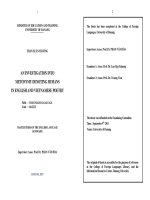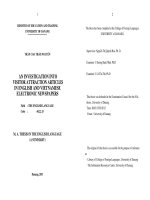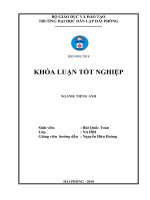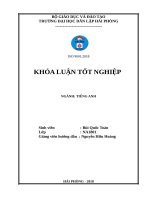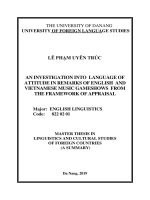An investigation into topic comment structures in english and vietnamese and some negative transfers to english by first year english majors at the university of danang, university of foreign language studies
Bạn đang xem bản rút gọn của tài liệu. Xem và tải ngay bản đầy đủ của tài liệu tại đây (280.85 KB, 4 trang )
ISSN 1859-1531 - THE UNIVERSITY OF DANANG, JOURNAL OF SCIENCE AND TECHNOLOGY, NO. 12(85).2014, VOL. 1
119
AN INVESTIGATION INTO TOPIC-COMMENT STRUCTURES IN ENGLISH
AND VIETNAMESE AND SOME NEGATIVE TRANSFERS TO ENGLISH
BY FIRST-YEAR ENGLISH MAJORS AT THE UNIVERSITY OF DANANG,
UNIVERSITY OF FOREIGN LANGUAGE STUDIES
Luu Quy Khuong1, Tran Thi Thuy Lien2
1
The University of Danang, University of Foreign Language Studies;
2
Vietnam Korea friendship Information Technology college;
Abstract - The concept of Topic - Comment sentence and the topiccomment structures have been a concern of linguistists in Vietnam
and in the world. According to Cao Xuan Hao (1991), Vietnamese
people often express ideas in the way that they start to mention a
topic and then say something about that topic or within the range of
that topic. However, the structure has been proved to be a hindrance
to the first-year English majors at the University of Foreign
Languages Studies, the University of Danang when transfered into
the English language. The paper investigates some commonly-used
topic-comment structures in Vietnamese and their negative transfers
to English by the first-year English majors at the University of Foreign
Languages Studies, the University of Danang. On the basis of data
analysis from a survey, the paper provides some suggestions to
better English learners’ translation of the structures.
Key words - topic; comment; structures; negative transfer; firstyear English majors.
1. Introduction
The concept of topic-comment sentence (TCS) is one
of the most controversial linguistic issues. It has been
observed that in some Vietnamese sentence types, the
subject, in terms of the obligatory subject-predicate
structure in English, is rather confusing to the students.
They find it difficult to locate the subject because
Vietnamese sentences do not require a grammatical subject
if it can be inferred from the context. For example, the
following sentence is quite common in Vietnamese:
(1) Nhà cửa
mua
thời điểm này
đắt lắm.
Houses
buy
now
expensive
TOPIC
COMMENT
OBJECT OF PREDICATE
THE VERB
It’s expensive to buy houses at present.
Sentences of this kind may place a burden to
Vietnamese students and translators. Firstly, the topic is not
the grammatical subject of the predicate. Rather, in terms
of deep structure, it is the object of the verb. Therefore, the
students and translators must go beyond the word level to
make sense of the “topic” and “comment” in the topiccomment sentences (TCSs), and correctly identify the
grammatical relationship between the predicate of the
sentence and the existing topic, which functions as the
object of the verb, and then express it as an object.
This paper investigates some commonly-used topiccomment structures in Vietnamese and their English
equivalents. On the basis of data analysis, it is hoped that the
paper can help to better learners’ translation of the structure.
Besides, the investigation is aimed at giving some suggestions
for teachers in Vietnamese-English translation teaching.
2. Previous Studies Related to the Research
Recently, many scholars have been showing their great
interest in studying issues related to topic-comment.
Hockett (1958) made a distinction between topic and
comment in a sentence, according to which “the speaker
announces a topic and then says something about it. In
English and languages of Europe, topics are usually also
subjects and comments are predicates” [16, p.201].
Li and Thompson (1976) set up many criteria to
distinguish the notion of subject and topic in their paper
entitled “Subject and Topic: a New Typology of Language”.
In Vietnam, many linguists have contributed to the
study of topic-comment structures. In “Tiếng Việt - Sơ thảo
ngữ pháp chức năng, tập 1” [Vietnamese languagepreliminary of funtional grammar, volume 1], Cao Xuan
Hao explicitly stated that topic-comment is the basic
structure. According to him, the way the Vietnamese
express themselves is that “when uttering a sentence, the
speaker produces a topic and says something about that
topic or within the frame of that topic” [13: 79].
Language transfer has been a central issue in applied
linguistics, second language acquisition and language
learning (Odlin 11). In 1989, Odlin published “Language
transfer: Cross-linguistic influence in language learning”
and his book has laid a foundation for recent language
transfer researches and studies. Different types and extents
of cross-linguistic influence as well as errors were discussed.
3. Some Theoretical concepts
3.1. Definitions of Topic-Comment Sentences
Gundel (1988:210) defined topic-comment as a
pragmatic relation that holds relative to a discourse
context. According to him, an entity is the topic of a
sentence, if in using the sentence the speaker intends to
increase the addressee’s knowledge about, request
information about, or otherwise get the addressee to act
with respect to that sentence.
The notion of topic and comment were prominently
introduced into American linguistic thinking by Hockett
(1958): “The most general characterization of predicative
constructions is suggested by the terms “topic” and
“comment” […]: The speaker announces a topic and then
says something about it.”
(2) As for my siblings, my sister lives in Lithuania, and
my brother lives in Armenia.
Here, As for my siblings constitutes the general topic,
120
Luu Quy Khuong, Tran Thi Thuy Lien
and my sister and my brother constitute subtopics. The
comment to as for my siblings is the rest of the sentence,
which itself consists of two topic/comment structures.
In his study, Hao stated: “when uttering a sentence, the
speaker produces a topic and says something about that topic
or within the range of that topic” (1991:79). That is to say,
when re-organizing the reflected reality, thought divides it
into two parts by choosing a point of departure for
establishing the relationship between these two. He assumes
that the part that is chosen as the point of departure functions
as topic and the remainder as comment (1991:33-4).
3.2. Types of Topic-Comment Structures in English
There are four types of topic-comment structures to be
discussed in this part.
The first type is a topic with a resumptive pronoun in
the comment clause. The topic is the antecedent of a
resumptive pronoun in the comment clause. The topic and
the resumptive pronoun have a coreferential referent.
(3) As for Mr. Li, I gave him five apples. (Xu and
Langendoen: 1985).
The second type of topic-comment structure is a
topicalized clause. For this type of construction, the topic
can be viewed as having been extracted from its original
postverbal object position, leaving a gap in its original
extraction site.
(4) As for Mr. Li, I know. (Xu and Langendoen: 1985).
The third type of topic-comment structure is double
nominatives construction. The most typical types of
semantic relationship between the two initial NPs in a
double nominative construction are domain-subset or
possess. In (4) the subject of the comment clause is
considered to be a subset of the domain of the topic NP.
(5) As for giraffes, their necks are long. (Kroeger: 2004).
The fourth type of topic-comment structure is an
adverbial phrase. Adverbial phrases are less common as
topics, they nevertheless serve as the semantic frame and
provide background information for the comment clause.
(6) In Thailand, you can eat many kinds of fruit (Xu and
Langendoen: 1985).
3.3. Topic-Comment Constructions in Vietnamese
According to Rosen (1998)’s categorization,
Vietnamese has the following kinds of topics:
a. Apparent long-distance dependencies
This kind of sentence has a gap in the comment which is
understood as being filled by the topic. This structure is
similar to the “topicalization” phenomenon in English where
a noun phrase is moved to the initial position of the sentence.
It leaves only an empty position in the rest of the sentence.
(7) Tơi thì
e
khơng
ngủ
được
topic
I
empty not
sleep
manage
marker
As for me, (I) couldn’t sleep. (Emeneau, 1951:54)
b. Noun phrase topics with coreferential noun
phrase in comment clauses
This type of topic corresponds to a coreferential noun
phrase or pronoun, which can be an overt subject or an
overt object in the comment.
(8) Tôi thì
tơi chỉ muốn về
Việt Nam
I
Topic Marker I
only wish return Vietnam
As for me, I only wish to return to Vietnam.(Chinh, 1970: 102)
c. Noun Phrase with semantically related noun
phrase in comment clause
The subject-predicate is embedded in topic-comment
sentences (in Li and Thompson's analysis, 1981:94).
(9) Cái phịng này thì
cửa
đóng
Classifier office this topic marker door closed
As for this office, the door is closed. (Li and Thompson: 1981)
Rosen named this “semantically related” because she
believed that the relationship between the noun phrase
topic and the noun phrase in the comment clause is nongrammatical.
d. Noun phrase topics with no related noun phrase
in comment clause
The noun phrase topic may not be related to any
constituent either empty or overt in the comment. Here is
an example:
(10) Sức thì
hai người ngang nhau
strength Topic Marker two people equal together
As far as strength is concerned, these two people are equal.
(Chinh, 1970:102)
e. Verb phrase and clausal topic
Sometimes, the topic consists of only a one-word verb
and it is repeated in the comment clause:
(10) Nói thì
bà Ba
nói
rất
nhiều
Talk
topic marker Mrs. Ba talk very much
As far as talking is concerned, Mrs. Ba talks very much.
(Chinh, 1970:103)
On the basis of theoretical background and its aims, the
research seeks to answer the following questions:
1. What are some typical similarities and differences
between topic-comment sentences in English and Vietnamese?
2. What are common negative transfers of TCSs from
Vietnamese to English?
3. What are possible causes of the negative transfer?
4. Methods and Procedures
Data description is the main method in the thesis. In
addition, qualitative and quantitative approaches were used.
Data were collected from results of a Vietnamese - English
translation task and responses to a questionnaire to find out
the students’ negative transfers and the possible causes.
Then statistics and tables were also carried out to clarify the
data and support the descriptive information. Negative
transfers were classified in terms of their possible sources.
A hundred first-year students from the University of
Foreign Languages Studies, the University of Danang were
randomly chosen to be the subjects of this study. All of them
major in English, which means that they have already
acquired certain knowledge of English. Those students were
ISSN 1859-1531 - THE UNIVERSITY OF DANANG, JOURNAL OF SCIENCE AND TECHNOLOGY, NO. 12(85).2014, VOL. 1
asked to do a Vietnamese - English translation task with 14
TCSs of different types. 50 students who had negative
transfer were asked to response to the questionnaire.
5. Findings and Discussion
In this section, the data collected from students’ translation
results and the questionnaire were analyzed, categorized and
explained in order to solve the research questions.
5.1. Typical Similarities and Differences between TopicComment Sentences in English and Vietnamese
Although the types of Vietnamese topic-comment
sentences in the corpus outnumber the English ones, they
share many similarities, one of which is that the topic
appears in the initial position and comment stands in the
remaining part of the sentence in both languages.
The second common similarity lies in the relationship
between the topic and the resumptive pronoun which have
a coreferential referent. In other word, the NP in the topic
appears again in the comment.
Another common feature is manifested in the semantic
relationship between the two initial NPs in the TCS.
Among this relationship; as Kroeger (2004) stated, the two
most common are domain-subset or possess.
In terms of syntactic relations, beside the clear
similarities mentioned, we can see that, not all sentence
topics are NPs, and in both languages, topic can be a
finite clause.
However, there are several important differences
creating challenges to the transfer of TCSs from one
language to the other.
Firstly, when the noun phrases (NP) in the topic and
the subject in the comment are co-referential, the subject
can be omitted in Vietnamese. However, it is impossible
to omit the subject in English. It is also noted that the NP
in the topic and in the comment is unchanged in
Vietnamese sentences while according to the grammatical
norm, there is a difference in terms of part of speech of
the two NPs in the English sentence. The topic marker “as
for” must be followed by an object and this object is
turned into a subject pronoun in the comment. In
Vietnamese, the topic marker does not change the form of
the NPs but the English topic marker may do, as in the
following examples:
Vietnamese
English
Nói, thì Bà Ba nói rất nhiều. As far as talking is concerned,
Mrs. Ba talks a lot.
5.2. Common Negative Transfers of Sentence TopicComment structures from Vietnamese to English
The following description summarizes the main types
of negative transfer found in the participants’ performance.
The categorization of negative topic-comment structures
may be subjective, as it is based on the judgment of the
researchers. Yet, due to the fact that all of the sentences
used in the translation task were composed on the basis of
the classification in the theoretical background, it was
believed that the findings would contribute to the
attainment of the research’s aims.
121
Table 1. List and Frequency of Negative Transfer of Sentence
Topic-Comment Structure Across 14 Sentences
Negative Transfer Type
Frequency Percentage
Omission of Topic
57
19.8%
Identification of Topic and
62
21.6%
Subject
Inaccurate Choice between
41
14.4%
Topic and Object in Comment
Too Free Translation of Topic
63
22%
when Topic coincides with the
Main Verb in the Comment
Literal
Translation
of
25
8.7%
Unmarked Topic in Existential
Sentences
Changing of Topic for a
39
13.5%
Prepositional
Phrase
in
Comment
TOTAL
287
100 %
Table 1 reveals the fact that a large number of students
felt confused with the topic constructions and as a result,
they were not able to transfer STCSs from Vietnamese to
English. As can be seen, more than a half of the students
attending the research omitted the topic or identified the
topic with the subject when translating it into English. As
we have predicted, TCSs are still a big challenge to
Vietnamese translators. Hence, 63 out of the 100 subjects
translated the structures freely:
Vietnamese
Negative transfer
Suggested
sentence
into English
transfer
Đi Sài Gịn thì 1. Go to Sai Gon, I go As for going to
tôi đi mỗi tuần three times a week. Saigon, I go three
ba lần.
2. Going to Sai Gon, I times every week.
go three times a week.
5.3. Possible Causes of Negative Transfers
Table 2. Distribution of Causes of Negative Transfers
from the questionnaire
Causes
Frequency
It is different from
Vietnamese syntactic
50
structures.
I don’t practice frequently.
29
I cannot understand the source
43
sentences.
I am influenced by the
61
Vietnamese language.
I forgot the rule.
27
I cannot apply the knowledge
of English when translating
39
the sentences.
The structure has not been
83
taught yet.
%
14.5
8.5
12.5
17.8
7.8
11.3
24.1
Very surprisingly, the answer that accounted for the
highest percentage (24.1%) is choice 7: “The structure has not
been taught yet”. This suggests the fact that sentence topiccomment structures are not concerned in English classrooms.
122
Luu Quy Khuong, Tran Thi Thuy Lien
This does not mean that the structures are not used but they
are not fully focused and emphasized by the teachers. The
Vietnamese language has a deep influence on the negative
transfer proved by the second highest choice (17.8%) of the
students. This can explain the third highest choice (14.5%):
“It is different from Vietnamese syntactic structures”.
5.4. Findings
After underlining and analyzing the six types of
negative transfer made by the first-year English majors and
possible causes, some findings are presented as follows:
Finding 1. Students with a high level of linguistic
competence still had difficulties in dealing with topiccomment structures at sentential level. The high number of
negative transfers indicates that the students focused
mainly on accessing words, rather than the sentence.
Finding 2. Among all types of negative transfer, free
translation of the topic when the topic coincides with the
main verb in the comment ranked the highest (22%). This
pinpointed one important fact: verbs in Vietnamese
sentences are not always present or easily identified. What
is more, Vietnamese language does not have the so-called
derivation like English.
Finding 3. Most of the negative transfer types are
related to the topic more than the comment and the
problems lie mainly in the inability to apply a suitable
structure to form a proper topic structure for each sentence.
The task will be simpler if Vietnamese students have
opportunity to get familiar with topic-comment structures
in both Vietnamese and English.
6. Conclusion
The results of the translation task revealed the popular
habit of word-by-word translation among the students.
Furthermore, a large number of students blamed their
errors on the teaching at school: they had not been taught
or introduced the so-called topic-comment structures at
school before. Some students who had a chance to study
the structures before admitted that their lack of practice
prevented them from translating successfully.
As a common structure in information structure system
and in communication, STCSs cannot be ignored in the
learning and teaching of both English and Vietnamese.
Learners should be equipped with different types of
TCSs in Vietnamese and in English. What is more, the
topic markers should be pointed out and taught so that
students can recognize and apply to transferring process
from this language to the other. Besides, people use TCSs
with different intentions. Therefore, understanding these
structures profoundly will develop their translation and
speaking skills as well.
When teaching Vietnamese students how to translate
Vietnamese TCSs into English, some specific contents
should be emphasized to students, including the syntactic
features of TCSs of the two languages and how to translate
different types of topic-comment structures of Vietnamese.
REFERENCES
[1] Chafe, W. (1976), Givenness, Contrastiveness, Definiteness,
Subjects, Topics, and Point of View, New York Academic Press.
[2] Chinh, T. V. (1970), Structure de la Langue Vietnamienne, Paris:
Imprimerie Nationale.
[3] Chao, Y. R. (1968), A Grammar of Spoken Chinese, University of
California Press.
[4] Corder, S. P. (1981), Error Analysis and Interlanguage, Oxford
University Press.
[5] Emeneau, Murray B. (1951), Studies in Vietnamese (Annamese)
Grammar. Berkeley / Los Angeles: University of California Press.
[6] Fuller, J. W., & Gundel, J. K. (1987), Topic-Prominence in
Interlanguage, Oxford University Press.
[7] Halliday, M. A. K., Mcintosh, A., & Strevens, P, (1964). The
Linguistic Sciences and Language Teaching, London: Longman.
[8] Hockett, Charles F. (1958), A Course in Modern Linguistics,
Macmillan.
[9] Li, C. N. & Thompson, S. A. (1976), Subject and Topic: A New
Typology of Language, In Charles N. Li, Subject and Topic,
Academic Press.
[10] Odlin, T. (1989), Language Transfer: Cross-linguistic Influence in
Language Learning, Cambridge University Press.
[11] Rosén, V. (1998), Topics and Empty Pronouns in Vietnamese,
Unpublished PhD Thesis, University of Bergen.
[12] Xu, L. & Langendoen, T. 1985. Topic Structures in Chinese,
Language 61. 1-27
[13] Cao Xuân Hạo (1991), Tiếng Việt-Sơ thảo ngữ pháp chức năng, tập
1, Nxb Khoa học Xã hội, Tp Hồ Chí Minh.
(The Board of Editors received the paper on 06/08/2014, its review was completed on 18/08/2014)
